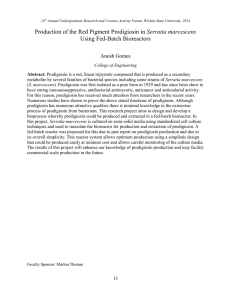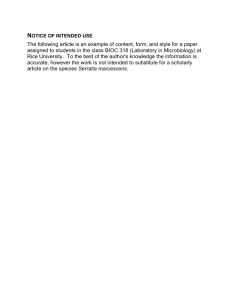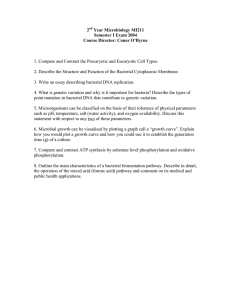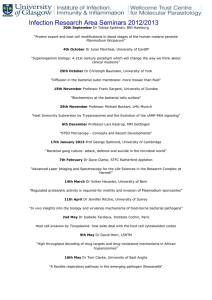Characterization of a Red Bacterium Strain Isolated from Root Nodule of Faba Bean (Vicia faba L.) for Growth and Pigment Production
advertisement
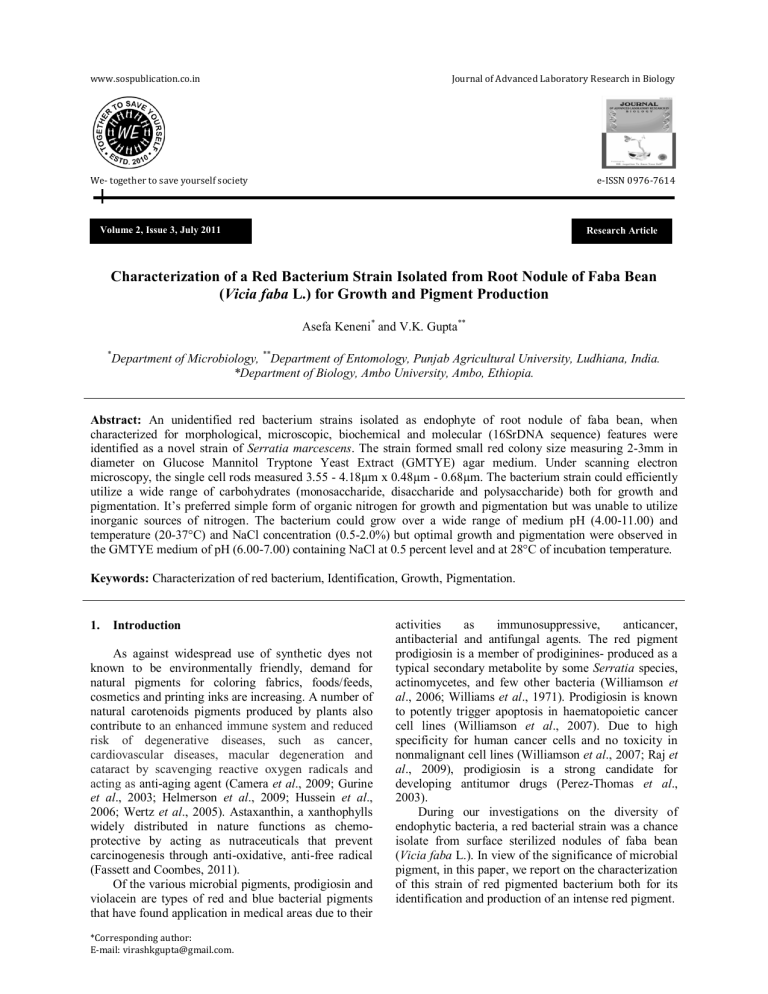
www.sospublication.co.in Journal of Advanced Laboratory Research in Biology We- together to save yourself society e-ISSN 0976-7614 Volume 2, Issue 3, July 2011 Research Article Characterization of a Red Bacterium Strain Isolated from Root Nodule of Faba Bean (Vicia faba L.) for Growth and Pigment Production Asefa Keneni* and V.K. Gupta** * Department of Microbiology, **Department of Entomology, Punjab Agricultural University, Ludhiana, India. *Department of Biology, Ambo University, Ambo, Ethiopia. Abstract: An unidentified red bacterium strains isolated as endophyte of root nodule of faba bean, when characterized for morphological, microscopic, biochemical and molecular (16SrDNA sequence) features were identified as a novel strain of Serratia marcescens. The strain formed small red colony size measuring 2-3mm in diameter on Glucose Mannitol Tryptone Yeast Extract (GMTYE) agar medium. Under scanning electron microscopy, the single cell rods measured 3.55 - 4.18µm x 0.48µm - 0.68µm. The bacterium strain could efficiently utilize a wide range of carbohydrates (monosaccharide, disaccharide and polysaccharide) both for growth and pigmentation. It’s preferred simple form of organic nitrogen for growth and pigmentation but was unable to utilize inorganic sources of nitrogen. The bacterium could grow over a wide range of medium pH (4.00-11.00) and temperature (20-37°C) and NaCl concentration (0.5-2.0%) but optimal growth and pigmentation were observed in the GMTYE medium of pH (6.00-7.00) containing NaCl at 0.5 percent level and at 28°C of incubation temperature. Keywords: Characterization of red bacterium, Identification, Growth, Pigmentation. 1. Introduction As against widespread use of synthetic dyes not known to be environmentally friendly, demand for natural pigments for coloring fabrics, foods/feeds, cosmetics and printing inks are increasing. A number of natural carotenoids pigments produced by plants also contribute to an enhanced immune system and reduced risk of degenerative diseases, such as cancer, cardiovascular diseases, macular degeneration and cataract by scavenging reactive oxygen radicals and acting as anti-aging agent (Camera et al., 2009; Gurine et al., 2003; Helmerson et al., 2009; Hussein et al., 2006; Wertz et al., 2005). Astaxanthin, a xanthophylls widely distributed in nature functions as chemoprotective by acting as nutraceuticals that prevent carcinogenesis through anti-oxidative, anti-free radical (Fassett and Coombes, 2011). Of the various microbial pigments, prodigiosin and violacein are types of red and blue bacterial pigments that have found application in medical areas due to their *Corresponding author: E-mail: virashkgupta@gmail.com. activities as immunosuppressive, anticancer, antibacterial and antifungal agents. The red pigment prodigiosin is a member of prodiginines- produced as a typical secondary metabolite by some Serratia species, actinomycetes, and few other bacteria (Williamson et al., 2006; Williams et al., 1971). Prodigiosin is known to potently trigger apoptosis in haematopoietic cancer cell lines (Williamson et al., 2007). Due to high specificity for human cancer cells and no toxicity in nonmalignant cell lines (Williamson et al., 2007; Raj et al., 2009), prodigiosin is a strong candidate for developing antitumor drugs (Perez-Thomas et al., 2003). During our investigations on the diversity of endophytic bacteria, a red bacterial strain was a chance isolate from surface sterilized nodules of faba bean (Vicia faba L.). In view of the significance of microbial pigment, in this paper, we report on the characterization of this strain of red pigmented bacterium both for its identification and production of an intense red pigment. Characterization of Red Bacterium Strain for Pigmentation 2. Materials and Methods 2.1 Red bacterium isolates The pure culture of the bacterium was maintained by subculturing on GMTYE-Agar (Tryptone, 10g/l; yeast extract, 3g/l; MgSO4.7H2O, 2g/l; mannitol, 5g/l; glucose, 5g/l; NaCl, 5g/l ; bacteriological agar 16g/l, pH 7.0) slants followed by storage at 4°C. When needed, culture was inconsistently derived from a master culture by streaking on GMTYE-Agar in order to maintain its genetic stability. The bacterial isolates when cultured on this medium at 282°C formed intense red colored colonies after an incubation period of 3-4 days. 2.2 Colony morphology and cell characterization The bacterium isolate was plated on GMTYE-Agar and allowed to grow at 282°C for 3-5 days and studied for different cultural and cell morphological parameters, such as colony size, colony elevations, colony margin and colony pigmentation. Motility (hanging drop method) and Gram’s reaction of the bacterial cells were performed using standard methods. 2.3 Bacterial cell morphology The bacterial cell size, cell shape and cell arrangement were observed through bright field, phase contrast and Scanning Electron Microscopy (SEM). Whereas, wet preparations were used for bright field and phase contrast microscopy, for SEM bacterial cell pellet (from one ml of the 48 hrs grown culture broth) was fixed in 2.5 percent glutaraldehyde in 0.1M cacodylate buffer (pH 7.4) for 30 minutes followed by three washings in the same buffer for 15 minutes each at 4°C. After secondary fixation with 1% osmium tetroxide (OsO4) for 1 hour at 4°C, the fixed cell mass was dehydrated in graded concentrations of ethanol (15, 30, 50, 70, 80, 90 and 100% ethanol in order) for 15 minutes in each grade at 4°C. The dehydrated cell mass was transferred onto a microscopic cover slide, dried under vacuum, soaked in isoamyl acetate and then dried to a critical point in ‘Hitachi HCP-2 vacuum drier’. The cell mass was mounted on carbon tape coated ‘aluminum stub of SEM’ and ‘gold sputtered (100300°A)’ in ‘sputter coater’ (Hitachi E-1010 Ion Sputter). The gold coated cell mass on the stub was examined under ‘scanning electron microscope’, (SEMHITACHI S-3400N, Thermo Electron Corporation) set at pre-standardized conditions (accelerating voltage15,000V, decelerating voltage- 0V, magnification14000- 18000x, working distance- 9900μm, emission current- 100,000nA and calibration scan speed- 25). The length and width (diameter) of the individual bacterial cells were measured with the SEM micromarker (photo-size 1000 micromarker 4000) and observations recorded in a photograph. 2.4 Biochemical test Various biochemical tests as per ‘Bergey’s Manual of Determinative Bacteriology’ (Holt et al., 1994) were J. Adv. Lab. Res. Biol. Keneni and Gupta performed on 48 hrs grown bacterial culture using standard protocols, such as; i. ii. iii. iv. Catalase, lipase and oxidase production (Cowan, 1974), Oxidative and fermentative metabolism of glucose, mannitol, maltose and sucrose (Hugh and Leifson, 1953), Koser’s citrate utilization and nitrate reduction (Cowan, 1974), and Hydrolysis of starch, cellulose, chitin and gelatin (Gordon, 1967). 2.5 Molecular identification of bacterial isolates based upon 16S ribosomal DNA (16SrDNA) sequence The total DNA isolated from the bacterial cell mass as per Cubero et al., (1999) was PCR amplified using 16SrDNA specific primers (PigB16S-F 5`cggcaggcttaacacatgca-3` & PigB16S-R 5`tctacgaatttcacctctacact-3`). The 25μL of PCR reaction mixture contained 20ng template (bacterial) DNA solution, 1mM dNTPs mix, 10μM of each primers, 2.0 U Taq Polymerase (MBI, Fermentas) and 1.5mM MgCl2 in 1X Taq reaction buffer. The PCR amplification program was consisted of 95°C for 5 min (preheating), 95°C for 1 min, 53°C for 1 min, 72°C for 2 min (36 cycles), 72°C for 10 min (final extension) and stored at 4°C until used. The amplified DNA product along with a DNA size marker (100 bp ladder plus, MBI Fermentas) was separated by electrophoresis using 1.0% agarose gel in TAE. The gel was stained with ethidium bromide and the banding profiles recorded using UV-Gel Documentation system (UltraLum). Amplified product (665 bp) was purified from the gel band (using ‘QIAquick Gel Extraction Kit’ of Qiagen), cloned in the PCR cloning vector pTZ57R/T using ‘InsTAclone PCR Product cloning kit’ (MBI Fermentas, USA) and transformed into E. coli DH5- alpha competent cells. The recombinant clone was submitted to M/S Xcelris, Ahmedabad, India for custom sequencing of the 16SrDNA using M13 primers. Identification of the bacterial isolate was ascertained based on nucleotide sequence homology of this 16SrDNA with the sequences available for different organisms in the GenBank database. 2.6 Effect of medium pH and NaCl concentration on growth and pigmentation In order to determine optimum conditions of medium pH or NaCl, the GMTYE broth medium was prepared (75ml lots in 250ml Erlenmeyer flasks) with different initial pH (3.0-11.0) values or NaCl concentrations (0.1-8.0 percent). The sterilized medium (15psi, 20 min) was inoculated with 0.1ml of bacterial inoculum (24 hrs growth of a single isolated clone in GMTYE) and incubated at 282°C under stationary conditions. After five days, the relative growth and extent of pigmentation was observed visually and recorded on a zero to ++++ Scale. 117 Characterization of Red Bacterium Strain for Pigmentation 2.7 Effect of incubation temperature Effect of incubation temperature (20 to 37°C) on the bacterial cell growth and pigmentation was observed after growing the inoculated complete GMTYE broth medium at different temperatures. After five days incubation period, the growth of the bacterial isolate was observed visually for relative growth and pigmentation. 2.8 Effect of carbon and nitrogen sources The effect of different carbon sources on the growth and pigmentation of the bacterial isolate was studied by supplying different carbohydrates as sole sources of carbon and energy (at 0.5 percent level) in GMTYE basal medium (less glucose and mannitol). Alternatively, the effect of different organic and inorganic nitrogen sources as sole sources of nitrogen was studied by supplying a respective nitrogen source (at the one percent level) in GMTYE basal medium (less yeast extract and tryptone). All the different GMTYE broths containing appropriate carbon or nitrogen sources were inoculated with standard inoculum and incubated at 282°C. After five days of incubation period, the growth and pigmentation of the bacterial isolate was visually determined as described earlier. 3. Results and Discussion 3.1 Colony morphology and cell characteristics 3.1.1 Colony morphology The colony morphology and cell characteristics of the bacterial isolate in GMTYE-Agar showed that within 3-5 days of incubation the bacterial isolate grew to form small round red colonies (2-3mm in diameter) having an entire margin and smooth and shiny surface with centrally raised colony elevation (Plate 1A). 3.1.2 Cell characteristics Gram staining of bacterial cells established it to be gram negative. Observations on the wet preparation of the bacterial isolate under bright field microscope Keneni and Gupta revealed that the bacterial cells were solitary short rod (single cell bacilli). Although few cells appeared joined end to end in pairs, the red pigment was observed as small red granule occupying a central position in the cell cytoplasm (Plate 2A). The finer details on cell shape and cell arrangements were however obtained under scanning electron microscope (SEM), wherein the bacterial cells were observed as thin long rods (Plate 2B). The cell length ranged between 3.55μm and 4.18μm with cell diameter/width ranging between 0.48μm and 0.69μm (Plate 2B). The larger cells (length and width) having grown to maximum size showed a prominent cell constriction (septum) in the middle suggesting that these mature cells were preparing to divide into daughter cells (Plate 2B). However, though the cells had earlier shown active motility (hanging drop method), flagella were not seen under the SEM, which might have been extricated (lost) during the vigorous pretreatments given for processing cell mass for SEM. 3.2 Biochemical characteristics The results on various biochemical tests revealed that the red bacterium was able to utilize/ hydrolyze starch, cellulose, chitin, gelatin and lipids, which established its ability to produce amylase, cellulase, chitinase, gelatinase and lipase enzymes. Though the bacterium expressed a positive catalase reaction, it showed only a negative reaction for oxidase, urease and H2S. Following the identification key based upon various morphological (colony morphology and cell characteristics) and biochemical characteristics as given by Bergey’s Manual of Determinative Bacteriology (Holt et al., 1994), the bacterium under study could be identified as Serratia marcescens. The colony characteristics and other features recorded for this bacterium also matched with those reported for different S. marcescens strains isolated from other diverse sources (Li et al., 2011; Holt et al., 1994; Langsrud et al., 2003; Tariq and Prabakaran, 2010), thus establishing the above identity of the red bacterial strain as S. marcescens. Plate 1. Growth and pigment production by the bacterial isolate in A & B: GMTYE-agar medium and C: GMTYE- liquid media at different incubation periods. J. Adv. Lab. Res. Biol. 118 Characterization of Red Bacterium Strain for Pigmentation Keneni and Gupta Plate 2. Cell characteristics of red bacterial Strain A- Bright field microscope at 1.0K- showing single celled rods with centrally located red pigment granule, and B -SEM at x9.0K; C-SEM at x15K; and D- SEM at x37 K- showing single cells and dividing cells with prominent cell constriction or septum. 3.3 Molecular identification of bacterial isolates based upon 16S rDNA sequence Using the total DNA of the red bacterium isolate as a template, the PCR amplification with PigB16S primers resulted in amplification of 665 bp DNA fragment (Fig. 1). The determined sequence of this 16SrDNA fragment was submitted to GenBank and is available as GenBank Accession #JF798453 (www.ncbi.nlm.nih.gov/Blast). This sequence was blasted into Nucleotide Blast Tool’ of ‘National Center for Biotechnology Information’ (available at www.ncbi.nlm.nih.gov/Blast) for nucleotide homology. The maximum homology report (Taxonomy Blast Report) identified a high nucleotide homology of the 16SrDNA (99% maximum identity in 100% query coverage) with 16SrDNA/ 16SrRNA sequences from 19 different Serratia marcescens strains (Table 1). From the analysis of the generated taxonomy report of the 16SrDNA gene sequence, this bacterial strain with the highest score of (1212), and lowest E-value (0.0) was identified to be Serratia marcescens. However, the bacterial strain under study showed a maximum of 99 percent homology with the previously reported sequences. This established that the bacterial isolate now identified as Serratia marcescens is a novel strain (S. marcescens, faba bean) that has not been reported earlier. It is to be noted that observed colony morphology, cell characteristics and biochemical characteristics of the isolate under study pointing to the above identity of the bacterial isolate also matched with those reported for other strains of S. marcescens (Li et al., 2011; Holt et al., 1994; Langsrud et al., 2003; Tariq and Prabakaran, 2010; de Araujo et al., 2010). Fig. 1. PCR amplification of 665 bp 16s rDNA from total DNA of red bacterial strain. M is 100 bp DNA ladder (MBI Fermentas). Table 1. Taxonomy Blast Report on 16S rDNA sequence with GenBank Database (http://www.ncbi.nlm.nih.gov/blast). Accession No. dbj|AB244453.1| dbj|AB244433.1| dbj|AB244291.1| gb|EU048327.1| gb|AF124040.1| gb|HM047514.1| gb|HQ260324.1| gb|FJ608004.1| gb|FJ462701.1| emb|FM207962.1| gb|EU221361.1| gb|EF627046.1| gb|DQ501957.1| gb|EF208031.1| J. Adv. Lab. Res. Biol. Serratia marcescens [enterobacteria] taxid Serratia marcescens strain An17-1 16S rRNA Serratia marcescens strain A19-1 16S rRNA Serratia marcescens gene for 16S rRNA Serratia marcescens strain CMG3090 16S rRNA Serratia marcescens 16S rRNA Serratia marcescens strain DHU-35 16S rRNA Serratia marcescens strain JNB5-1 16S rRNA Serratia marcescens strain LM8 16S rRNA Serratia marcescens strain AKL1 16S rRNA Serratia marcescensstrain CWS25 16S rRNA Serratia marcescens strain J2P3 16S rRNA Serratia marcescens strain cocoon-1 16S rRNA Serratia marcescens 16S rRNA Serratia marcescens strain L1 16S rRNA Score E-Value 1212 0.0 1212 0.0 1212 0.0 1212 0.0 1212 0.0 1210 0.0 1206 0.0 1206 0.0 1206 0.0 1206 0.0 1206 0.0 1206 0.0 1206 0.0 1206 0.0 Query coverage, % 100 100 100 100 100 100 100 100 100 100 100 100 100 100 Maximum Identity, % 99 99 99 99 99 99 99 99 99 99 99 99 99 99 119 Characterization of Red Bacterium Strain for Pigmentation Keneni and Gupta 3.4 Red Pigment development The now identified S. marcescens faba bean produced red pigment both on solid GMTYE-Agar and in liquid GMTYE medium, but the pigment production was rapid and more intense on solid than in the liquid medium (Plate 1). On solid medium, the colony remained white up to 16 hrs of incubation period. Thereafter, colony color changed to light red to intense red by 24h and turning dark intense red by 72 hrs. However, in liquid medium, the appearance of pigment was observed only after 36 hrs with growth and pigmentation reaching maximum by 72 hours (Plate 1, Table 2). In the subsequent period, both growth and pigmentation showed only a slow decline. bacterial isolate was observed in the culture incubated at 28°C, followed by 25°C and 32°C (Table 3). However, as against growth over wider range of incubation temperatures, the cell pigmentation was observed at a narrow range of temperature 25-32°C. Though the observations are in accordance with those reported for other strains of S. marcescens, (Williams et al., 1971; Giri et al., 2004), the results suggest that the extent of pigmentation is somehow a function of active growth and the same is inhibited in poorly growing bacterial cultures of this bacterial species. 3.5 Effect of medium pH, NaCl and incubation temperature on growth and pigmentation by the bacterial isolate 3.6.1 Carbon sources The red bacterial strain Serratia marcescens faba bean, showed its ability to utilize all the different carbon sources for its growth and pigment production but to different extents (Table 4). Whereas, glucose and mannitol were the most efficiently utilized monosaccharide, maltose and sucrose as disaccharides were also metabolized by the bacterial strain with equal efficiency. The other mono- and disaccharides served only as a poor source of carbon and energy for the bacterial strain. The bacterial strain utilized all the three polysaccharides (cellulose, chitin and starch) though with reduced efficacy, which suggested the ability of the bacterium to metabolize the same for growth and pigment production. Most likely, this bacterial strain did not produce hydrolytic enzymes in enough concentration to efficiently degrade these polysaccharides for its efficient growth and hence pigment production. In this study, sugar alcohols (mannitol followed by erythrose) have found to be metabolized with efficiency equal or slightly lower than glucose. However, some other S. marcescens strains have also been reported which could utilize ethanol as sole carbon source for growth and pigment production better than glucose and could be attributed to differences amongst strains (Cang et al., 2000). Pigment production by Serratia marcescens has also been reported to be highly variable among its strains and is dependent on several cultural and nutritional parameters (Giri et al., 2004). 3.5.1 Medium pH The effect of pH value of the liquid medium on growth and pigment production by S. marcescens faba bean was studied by allowing the bacterial culture to grow in GMTYE media prepared with different initial pH values (3.0, 4.0, 5.0, 6.0, 6.5, 7.0, 8.0, 9.0 and 11.0). The bacterial isolate showed remarkable ability to grow and produce red pigment over a wide range of medium pH of 4.0-11.0. However, it showed its maximum growth and pigmentation efficiency at pH values of 6.07.0 (Table 3). It suggested that pigmentation was directly related with growth and that in spite of its capacity to grow over a wide pH range, the bacterial isolate was neutrophilicin its nature. 3.5.2 NaCl concentration In order to determine the effect of different concentration of salt, the bacterial isolate was grown in GMTYE medium containing different concentrations of sodium chloride (0.1, 0.5, 1.0, 1.5, 2.0, 3.0, 4.0, 5.0 and 8.0 percent). The S. marcescens faba bean showed its ability to actively grow and produce red pigment in the range of 0.1-2.0 percent NaCl concentration but optimum growth and pigmentation was observed at only at lower salt concentrations of 0.5-1.0 percent (Table 3). Higher concentrations than this had inhibitory influence with only a scanty growth at a salt concentration of 2.0 percent with concentrations higher than this being inhibitory for growth and pigment formation. Requirement of NaCl for growth and pigmentation by different pigmented bacteria including Serratia marcescens have already been reported by Allen et al., (1983) and Silverman and Munoz (1973). 3.5.3 Temperature In order to determine the optimum temperature, for the growth and pigmentation of the bacterial isolate in GMTYE medium was observed at five different incubation temperatures (20, 25, 28, 32 and 37°C). All the incubation temperature allowed the growth of the bacterial isolate. However, the optimum growth of the J. Adv. Lab. Res. Biol. 3.6 Effect of carbon and nitrogen sources on growth and pigmentation by the bacterial isolate 3.6.2 Nitrogen sources Of the five different organic sources, beef extract, peptone and tryptone supported maximum growth and pigmentation, while casein and gelatin were only poorly utilized for the purpose. This suggested that though bacterial strain could efficiently utilize the relatively pre-hydrolyzed proteins (beef extract, peptone and tryptone), this species possessed only a reduced ability to hydrolyze intact proteins (Cang et al., 2000 and Wei and Chen, 2005). The bacterial isolate did not utilize any of the three inorganic nitrogen sources (Urea, KNO3, (NH4)2SO4) tested for growth and pigment accumulation. 120 Characterization of Red Bacterium Strain for Pigmentation Keneni and Gupta Table 2. Relative growth and cell pigmentation of bacterium isolate at different incubation time. Incubation period (hrs) 12 24 36 48 60 72 84 96 108 120 132 144 Growth + ++ ++ +++ +++ ++++ +++ +++ +++ +++ +++ +++ Cell Pigmentation + ++ +++ ++++ +++ +++ +++ +++ +++ +++ ‘-’ or ‘+’ sign represent no or positive visual growth and pigmentation. Number of ‘+’ signs stand for relative extent of visual growth and pigmentation. Parameter Table 3. Effect medium pH, NaCl concentration and incubation temperature on the growth and pigmentation of the red bacterial isolate Medium pH 6.5 7.0 8.0 9.0 11.0 Growth ++++ ++++ +++ ++ ++ Pigmentation ++++ ++++ +++ ++ ++ NaCl (%) 0.1 0.5 1.0 1.5 2 3 4 5 8 Growth ++ +++ +++ ++ ++ + + Pigmentation ++ +++ +++ ++ + + + Incubation Temperature °C 20 25 28 32 37 Growth ++ ++ +++ ++ + Pigmentation + ++ + ‘-’ or ‘+’ sign represents no or positive visual growth and pigmentation. Number of ‘+’ signs stand for relative extent of visual growth and pigmentation. Parameter 3.0 - 4.0 + + 5.0 ++ ++ 6.0 ++++ ++++ Table 4. Relative growth and pigment production by the bacterial isolate on media supplied with different carbon and nitrogen sources Carbon source Mal Suc Cell Chi Star Growth +++ +++ ++ ++ ++ Cell Pigmentation +++ +++ ++ ++ ++ Nitrogen source BE Cas Gela Pep Tryp YE KNO3 Urea (NH4)2SO4 Growth +++ ++ ++ +++ +++ ++ Cell Pigmentation +++ ++ ++ +++ +++ ++ ‘-’ or ‘+’ sign represents no or positive visual growth and pigmentation. Number of ‘+’ signs stand for relative extent of visual growth and pigmentation. Cell- Cellulose, Chi- Chitin, Eryt- Erythrose, Glu- Glucose, Lac- Lactose, Mal- Maltose, Man- Mannitol, Star- Starch, Suc- Sucrose, BE- Beef Extract, Cas- Casein, Gela- Gelatin , Pep- Peptone, Tryp- Tryptone, YE- Yeast extract. Parameter 4. Eryt ++ ++ Glu +++ +++ Man +++ +++ Lac ++ ++ Conclusions Based upon different morphological microscopic, biochemical and molecular parameters, the red pigmented bacterial strain isolated as an endophyte of faba bean root nodule was identified as a novel strain of Serratia marcescens. This strain could actively grow and produce red pigment in medium containing 0.51.0% NaCl and have an initial pH of 6.0-7.0 and at an incubation temperature of 28°C. The bacterial strain could efficiently utilize only simple organic nitrogen sources in the presence of simple sugars such as glucose, mannitol, maltose and sucrose with additional ability to use starch, chitin and cellulose though with slightly reduced efficiency. References [1]. Allen, G.R., Reichelt, J.L. and Gray, P.P. (1983). Influence of environmental factors and medium composition on Vibrio gazogenes growth and prodigiosin production. Appl. Environ. Microbiol., 45:1727-1732. J. Adv. Lab. Res. Biol. [2]. Camera, E., Mastofrancesco, A., Fabbi, C., Daubrawa, F., Picardo, M., Sies, H. and Stahl, W. (2009). Astaxanthin, canthaxanthin and betacarotene differently affect UVA-induced oxidative damage and expression of oxidative stress-responsive enzymes. Exp. Dermatol., 18: 222- 231. [3]. Cang, S., Sanada, M., Johdo, O., Ohta, S. and Yoshimoto, A. (2000). High production of prodigiosin by Serratia marcescens grown on ethanol. Biotechnol. Lett., 22: 1716-1765. [4]. Cowan, S.T. (1974). Cowan and Steel`s manual for the identification of medical Bacteria, 2nd ed. Cambridge: Cambridge University Press. [5]. Cubero, J., Martinez, M.C., Llop, P. and Lopez, M.M. (1999). A simple and efficient PCR method for the detection of Agrobacterium tumefaciens in plant tumors. J. Appl. Microbiol., 86: 591-602. [6]. de Araújo, H.W., Fukushima, K. and Takaki, G.M. (2010). Prodigiosin production by Serratia marcescens UCP 1549 using renewable-resources as a low cost substrate. Molecules, 15: 6931-6940. 121 Characterization of Red Bacterium Strain for Pigmentation [7]. Fassett, R.G. and Coombes, J.S. (2011). Astaxanthin: a potential therapeutic agent in cardiovascular disease. Mar. Drugs., 9: 447-465. [8]. Giri, A.V., Anandkumar, N., Muthukumaran, G. and Pennathur, G. (2004). A novel medium for the enhanced cell growth and production of prodigiosin from Serratia marcescens isolated from soil. BMC Microbiol., 4: 11 available at http://www.bimedcentral.com/1471-2180/4/11. [9]. Gordon, R.E. (1967). The Taxonomy of soil bacteria. In: The Ecology of soil bacteria, pp 293321, ed. Gray T.R.G and Parkinson D. Liver Pool: Liverpool University Press. [10]. Guerin, M., Huntley, M.E. and Olaizola, M. (2003). Haematococcus astaxanthin: Applications for human health and nutrition. Trends Biotechnol., 21: 210-216. [11]. Helmerson, J., Arlov, J., Larsson, A. and Basu, S. (2009). Low dietary intake of beta-carotene, alpha-tocopherol and ascorbic acid is associated with increased inflammatory and oxidative stress status in a Swedish cohort. Br. J. Natr., 101: 1775-1782. [12]. Holt, J., Krieg, N., Stanely, P. and William, R. (1994). Enterobacteriaceae In: Bergey`s manual of Determinative Bacteriology 9th ed. Baltimore: Williams and Walk in Co. pp: 87-175. [13]. Hugh, R. and Leifson, E. (1953). The taxonomic significance of fermentative versus oxidative metabolism of carbohydrates by various Gram negative bacteria. J. Bacteriol., 66: 24-26. [14]. Hussein, G., Sankawa, U., Goto, H., Mastumoto, K. and Watanabe, H. (2006). Astaxanthin, a carotenoid with potential in human health and nutrition. J. Nat. Prod., 69: 443-449. [15]. Langsrud, S., Moretro, T., Sundheim, G. (2003). Characterization of Serratia marcescens surviving disinfecting footbaths. J. Appl. Microbiol., 95: 186-195. [16]. Li, B., Yu, R., Liu, B., Tang, Q., Zhang, G., Wang, Y., Xie, G. and Sun, G. (2011). Characterization and comparison of Serratia marcescens isolated from edible cactus and from silkworm for virulence potential and chitosan susceptibility. Braz. J. Microbiol., 42: 96-104. J. Adv. Lab. Res. Biol. Keneni and Gupta [17]. Perez-Tomas, R., Montaner, B., Llagostera, E. and Soto-Cerrato, V. (2003). The prodigiosins, proapoptotic drugs with anticancer properties. Biochem. Pharmacol., 66: 1447-1452. [18]. Raj, D.N., Dhanasekaran, D., Thajuddin. N. and Panneerselvam, A. (2009). Production of prodigiosin from Serratia marcescens and its cytotoxicity activity. J. Pharma. Res., 2: 590-593. [19]. Silverman, M.P. and Munoz, E.F. (1973). Effect of iron and salt on prodigiosin synthesis in Serratia marcescens. J. Bacteriol., 114: 999-1006. [20]. Tariq, A.L. and Prabakaran, J.J. (2010). Molecular characterization of psychrotrophic Serratia marcescens TS1 isolated from apple garden at Badran Kashmir. Res. J. Agric. Biol. Sci., 6: 364369. [21]. Wei, Y.H. and Chen, W. (2005). Enhanced production of prodigiosin-like pigment from Serratia marcescens SMdeltaR by medium improvement and oil-supplementation strategies. J. Biosci. Bioeng., 99: 616-622. [22]. Wertz, K., Hunziker, P.B., Seifert, N., Riss, G., Neeb, M., Steiner, G., Hunziker, W. and Goralczyk, R. (2005). Beta-Carotene interferes with ultraviolet light A-induced gene expression by multiple pathways. J. Invest. Dermatol., 124: 428-434. [23]. Williams, R.P., Gott, C.L., Qadri, S.M.H. and Scott, R.H. (1971). Influence of temperature of incubation and type of growth medium upon pigmentation in Serratia marcescens. J. Bacteriol., 106: 438-443. [24]. Williamson, N.R., Simonsen, H.T., Harris, A.K., Leeper, F.J. and Salmond, G.P. (2006). Disruption of the copper efflux pump (CopA) of Serratia marcescens ATCC 274 pleiotropically affects copper sensitivity and production of the tripyrrole secondary metabolite, prodigiosin. J. Ind. Microbiol. Biotechnol., 33: 151–158. [25]. Williamson, N.R., Fineran, P.C., Gristwood, T., Chawrai, S.R., Leeper, F.J. and Salmond, G.P. (2007). Anticancer and immunosuppressive properties of bacterial prodiginines. Future Microbial., 2: 605-618. 122
